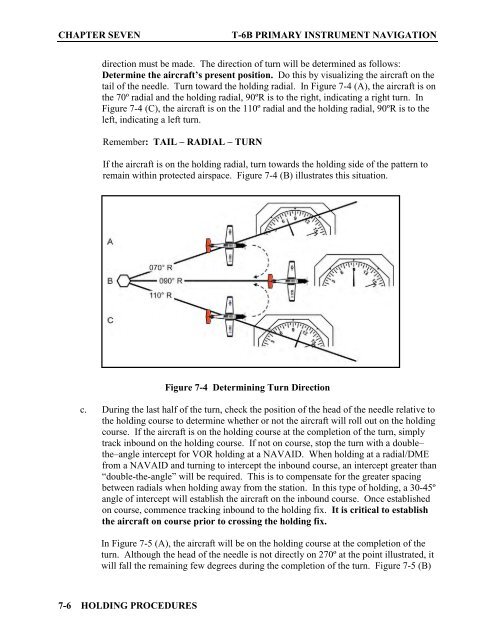Flight Training Instruction - Cnatra - U.S. Navy
Flight Training Instruction - Cnatra - U.S. Navy
Flight Training Instruction - Cnatra - U.S. Navy
You also want an ePaper? Increase the reach of your titles
YUMPU automatically turns print PDFs into web optimized ePapers that Google loves.
CHAPTER SEVEN T-6B PRIMARY INSTRUMENT NAVIGATION<br />
direction must be made. The direction of turn will be determined as follows:<br />
Determine the aircraft’s present position. Do this by visualizing the aircraft on the<br />
tail of the needle. Turn toward the holding radial. In Figure 7-4 (A), the aircraft is on<br />
the 70º radial and the holding radial, 90ºR is to the right, indicating a right turn. In<br />
Figure 7-4 (C), the aircraft is on the 110º radial and the holding radial, 90ºR is to the<br />
left, indicating a left turn.<br />
Remember: TAIL – RADIAL – TURN<br />
If the aircraft is on the holding radial, turn towards the holding side of the pattern to<br />
remain within protected airspace. Figure 7-4 (B) illustrates this situation.<br />
7-6 HOLDING PROCEDURES<br />
Figure 7-4 Determining Turn Direction<br />
c. During the last half of the turn, check the position of the head of the needle relative to<br />
the holding course to determine whether or not the aircraft will roll out on the holding<br />
course. If the aircraft is on the holding course at the completion of the turn, simply<br />
track inbound on the holding course. If not on course, stop the turn with a double–<br />
the–angle intercept for VOR holding at a NAVAID. When holding at a radial/DME<br />
from a NAVAID and turning to intercept the inbound course, an intercept greater than<br />
“double-the-angle” will be required. This is to compensate for the greater spacing<br />
between radials when holding away from the station. In this type of holding, a 30-45º<br />
angle of intercept will establish the aircraft on the inbound course. Once established<br />
on course, commence tracking inbound to the holding fix. It is critical to establish<br />
the aircraft on course prior to crossing the holding fix.<br />
In Figure 7-5 (A), the aircraft will be on the holding course at the completion of the<br />
turn. Although the head of the needle is not directly on 270º at the point illustrated, it<br />
will fall the remaining few degrees during the completion of the turn. Figure 7-5 (B)
















